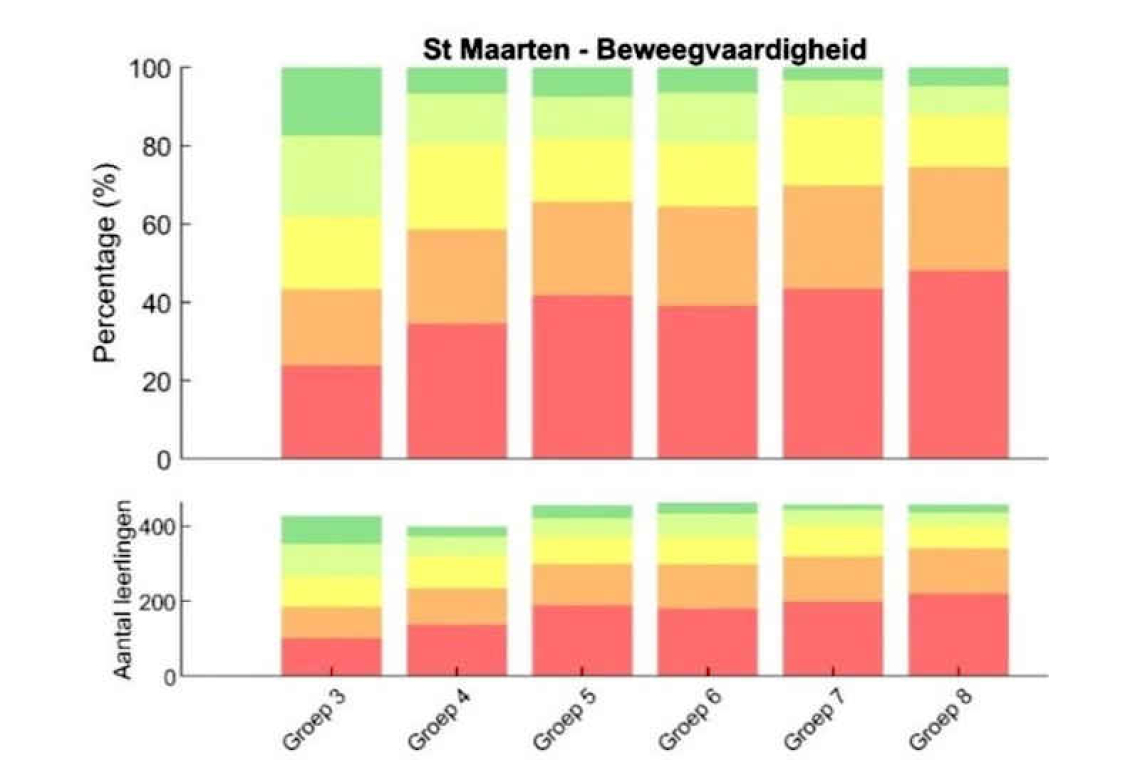~Scores decline among older students~
Data is key to decision-making, so while everyone would arguably be on board in improving children’s health in general, data collected in two major studies on St. Maarten youth, are providing much-needed insight that can be used as guidance by schools, physical education (PE) teachers, and government. Results of these two studies, focussing on both lifestyle habits and motor skill development, were presented to receptive listeners from a broad cross-section of stakeholders in children’s education in the Government building earlier this month by Juriaan Otto. Otto is a former PE teacher, and is now the Project Leader for Healthy Schools and Communities for Foundation EGO (Stichting Expertisecentrum Ervaringsgericht Onderwijs).
The two studies were conducted across the overwhelming majority of Dutch Side schools –17. The BLOC test, being introduced by the HAN University of Applied Sciences, focusses on measuring motor skill development and tested a total of 2,657 students’ capabilities. Each child receives an extensive report, and the test will be repeated every year for continued monitoring if their development. PE teachers are being trained on how to work with the data. Positive results could for example flag students with excellent capabilities, and encourage them to pursue sports professionally, while results that are lacking can shine light on what specific motor skills should be worked on.
Considering the combined results as a group, a picture emerges of the need to incorporate better physical education into the school system. Worth noting is that many of the schools lack either a PE teacher, gym, or sports equipment – which all contribute to positive development. Combined with the other study on lifestyle habits, a better picture is formed of the children’s overall health. Results from the Child Monitor, centred on lifestyle habits, will be discussed in another article.
For the BLOC test, the children were scored on four motor skills: balancing, sideways jumping, lateral movement, and eye-hand coordination. Their scores were compared to a database of scores of a comparable group from a large study in the Netherlands.
Unfortunately, the majority of children score worse than their counterparts in The Netherlands, when it comes to the big picture: overall movement skill. Some 63% in total scored below or significantly below average, while 17% were average and 20% were above or significantly above average. Scores were particularly worse for sideways jumping and lateral movement in particular, where 71% and 64% respectively scored below or significantly below average. In an invited comment, researchers told “The Daily Herald” that these concern locomotive skills, and are connected to activities that take stability and balance while changing direction of the body, such as dancing, track and field, volleyball, basketball, and climbing/bouldering.
Results for balancing were more positive, the only category where the group of students scoring average or above was more than half (average 19%, above or significantly above average 44%).
Breaking down the total movement skill by age groups, results also clearly show that these motor skill scores are much better for the younger children, but steadily worsen as they get older. In group 3 (around age 6), there is not much difference between children who score (significantly) below or above average. However, the (significantly) above-average group declines steadily while the (significantly) below-average group increases. By group 8 (around age 11), the significantly below-average group is 47%, compared to 23% for group 3. The above-average group is 10%, compared to 20%, and the significantly above-average group is 5%, compared to 18%.
While not a definitive comparison, the lifestyle study does show that younger children play outside more often, and have less screen-time than older children.
In a booklet provided by researchers about the BLOC test, it is noted that there has been a decline in children’s movement skills for years. “In 2016, the Education Inspectorate showed that children in grade 8 scored worse on several skills than in the 2006 survey. And in 2006, children already scored worse than at the poll in 1996. Frequently cited causes include children playing outside less and less often, an increase in the time they spend behind screens, dual-earning parents who have (too) little time for the children and the quality of the staff at sports clubs.”
The authors also point out that “movement skills do not develop by themselves. Children need to be challenged and encouraged to move, and especially to learn to move. With a changing society, there is an increasing importance of doing this in education.”
The BLOC study and Child Monitor report were carried out in collaboration with the St. Maarten Development Fund (SMDF), the Department of Collective Prevention Services (CPS), and the Department of Sports. Research was funded by the Representation of the Netherlands in Aruba, Curaçao and St. Maarten VNACS, CPS, and JOGG Netherlands.
Graphic: A local study of primary school children shows that scores for overall movement skill are much better with younger children than with older ones. This underscores the need for children to be encouraged to move.







